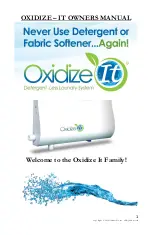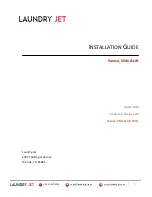
Using the decorating tips
Use the Decorating Tips to decorate cookies and
other desserts.
Follow the steps for ‘Using the Cookie Factory’
and insert your chosen Decorating Tip into the
Disc/Tip Adapter.
Fill the Dough Barrel with freshly made icing (see
recipes, page 8).
A steady hand and some patience are required
when decorating cookies and cakes. Practice
makes perfect.
CARE AND CLEANING
It is essential that the Cookie Factory is cleaned
after every use to maintain optimal performance.
Follow these simple steps for cleaning.
Turn the Disc/Tip Adapter anti-clockwise
and remove from Dough Barrel.
Remove Cookie Disc or Decorating Tip from
the Disc/Tip Adapter.
Turn the Dough Barrel anti-clockwise to
remove from the Main Body.
Hold onto the Press Disc and gently pull to
remove the Shaft from the Main Body.
Turn the Locking Disc anti-clockwise and
remove it from the Main Body.
Remove batteries from Battery
Compartment before cleaning Main Body.
Use a damp cloth to wipe the exterior of
the Main Body and dry thoroughly. Ensure
to clean around the assembly area of the
main body to remove any dough that may
have become lodged. Be careful that water
does not get into the internals of the Cookie
Factory.
Wash all the attachments (Locking Disc,
Shaft, Press Disc, Dough Barrel, Cookie Discs
and/or Decoration Tips, Disc/Tip Adapter
and Dough Barrel Cover in warm, soapy
water. It may be necessary to use a soft brush
to remove dough lodged in crevices of the
attachments.
Rinse well and dry thoroughly.
NOTE: Never immerse the Main Body or Battery
Compartment in water or any other liquid.
NOTE: Do not wash any parts or accessories of the
Cookie Factory in dishwasher.
NOTE: Clean the Cookie Factory immediately after
use. It is difficult to clean of dough has dried and
hardened.
Storage
Always remove the batteries before storing if the
Cookie Factory will not be used for an extended
period of time.
Store the Cookie Factory out of direct sunlight.
Note: The Hanging Loop makes storing the Cookie
Factory easy and convenient. Hang on a hook in a
safe place such as a kitchen cupboard.
1.
2.
3.
4.
5.
6.
7.
8.
9.
HINTS fOR WEIGHING AND
MEASURING
Care should be taken when weighing and
measuring ingredients to achieve accuracy and
consistency.
Recipes in this instruction book have been
developed using Australian metric weights and
measurements.
The New Zealand tablespoon is 5ml less than the
Australian tablespoon, so care should be taken
when measuring ingredients to compensate for
the variance. For example, 1 Australian tablespoon
= 1 New Zealand tabl 1 New Zealand
teaspoon.
AUSTRALIAN METRIC MEASUREMENTS
MLS
1 TEASPOON
5
1 TABLESPOON
20
1 CUP
250
NZ METRIC MEASUREMENTS
MLS
1 TEASPOON
5
1 TABLESPOON
15
1 CUP
250
Metric weighing scales
For consistent results it is recommended that a
set of metric weighing scales be used to weigh
larger quantities as they provide greater accuracy
than measuring cups.
Tare (zero) the scales with the container in
position then spoon or pour ingredients in until
the desired weight is achieved.
Metric measuring cups and spoons
If using graduated metric measuring cups, it is
important to spoon the dry ingredients loosely
into the required cup. Do not tap the cup on the
bench or pack the ingredients into the cup unless
otherwise directed. Level the top of the cup with
a knife. When using graduated metric measuring
spoons, level the top of the spoon with a straight
edged knife or spatula.
Metric liquid measuring jugs
If using a graduated, metric measuring jug, place
jug on a flat surface and check for accuracy at eye
level.
KCP100_COOKIE FACTORY_FA.indd 8-9
30/5/08 11:48:01 AM
























